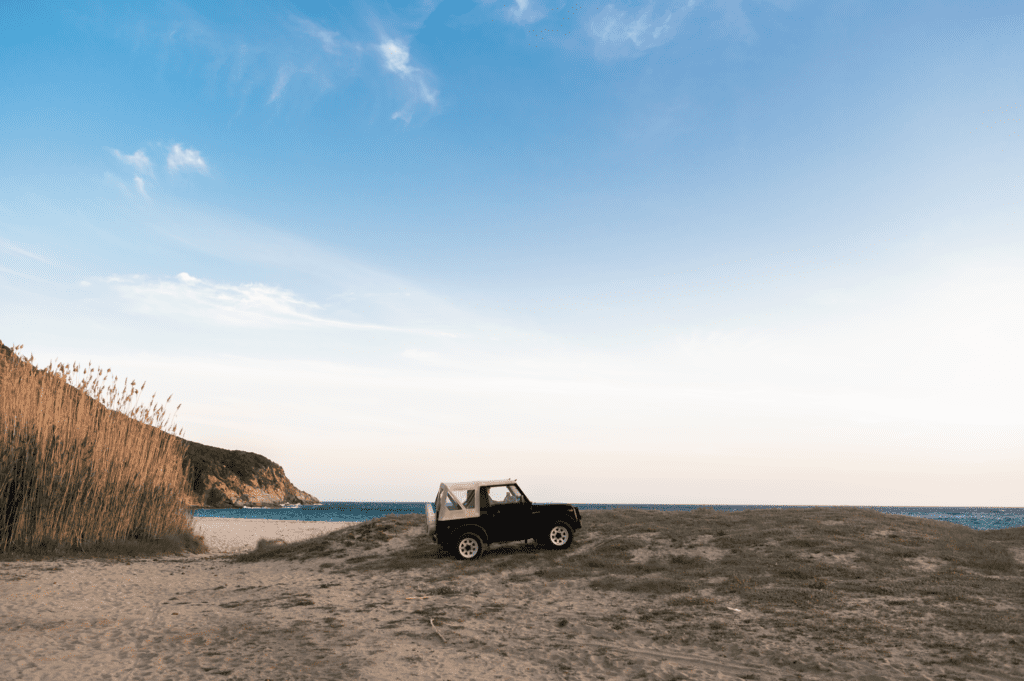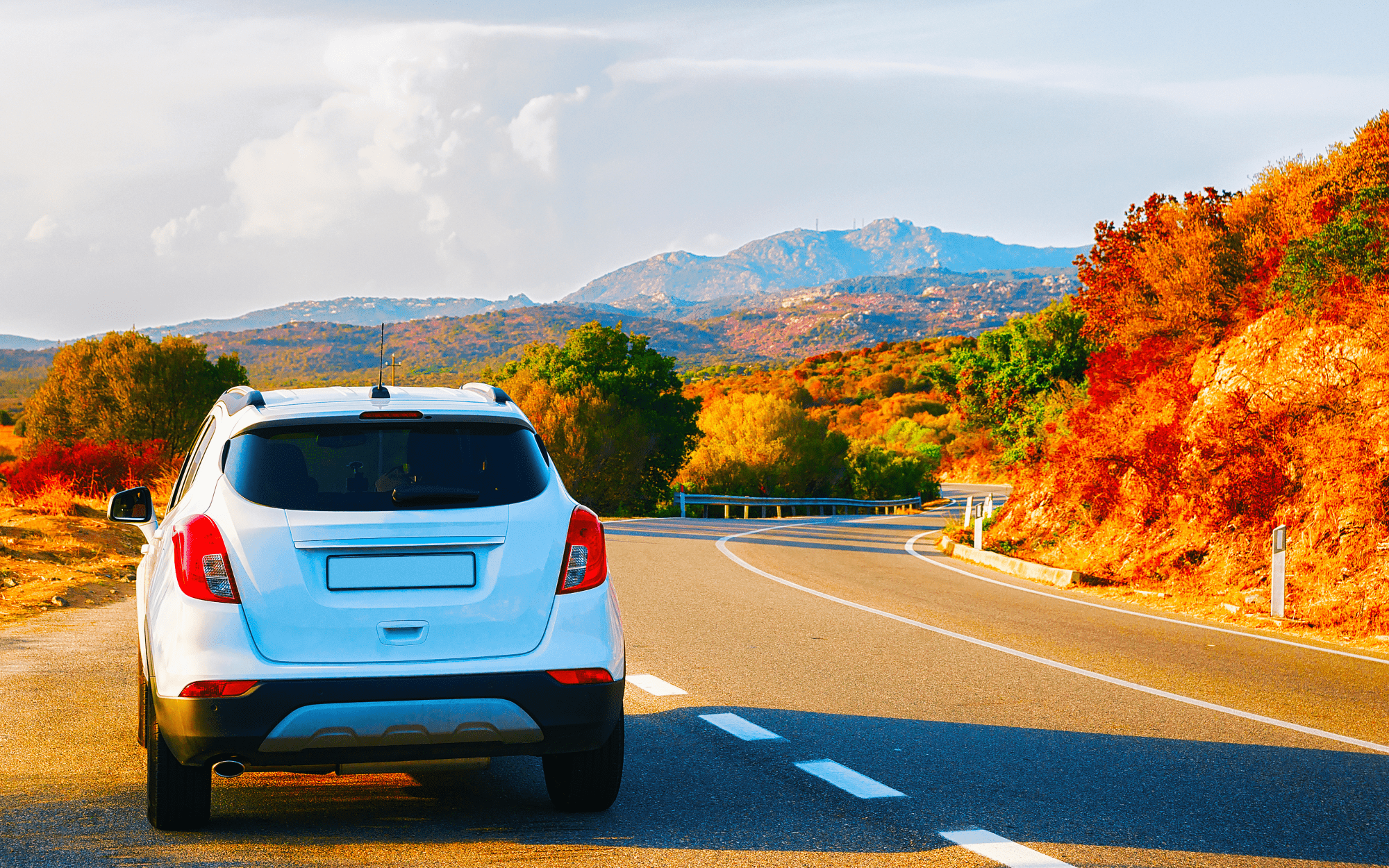Driving in Sardinia, on the whole, is hassle-free, local drivers are courteous, traffic is confined only to the significant towns and the driving culture isn’t like that which you find in Naples or Rome. However, there are a few key things to take note of when driving in Sardinia to ensure safe and enjoyable driving.

Drive With Confidence
Obviously, don’t drive in a way that is dangerous to yourselves or other roads users. Most drivers on the island are courteous, but they may interpret hesitations, to mean that you are not going, and they will drive around you. You should try to drive assertively, with confidence and make your intentions visible to other road users, using indicators and positioning yourself correctly.
Fold In Side Mirrors When Parking
It can be frustrating to return to your car to see the side mirrors damaged or even on the ground. Sardinia and Italy, in general, has many narrow streets, especially in historic areas. So before leaving, make sure that the side mirrors are tucked in as there will be other vehicles that travel by and with the limited space its sure to be a tight squeeze.
Be Aware Of Restricted Traffic Zones (ZTL – Zona A Traffico Limitato)
In the cities of Alghero, Cagliari, Nuoro, Pula, and Sassari, there exists a restricted traffic zone. These zones are in place all across Italy, to create traffic-free areas in historical centers across the country, you will be aware of this if you have visited other cities on the mainland with a car. If you accidentally find your way into the zone, you will automatically be sent a ticket. The zones are monitored with cameras and tickets are issued on the spot, if the car is rented, then you will be billed by the rental company If you are unaware of this you could find yourself following vehicles into the zone that are locals with passes or emergency vehicles, leading to a fine. This is usually between 50-80 Euros, depending on the city.
If you can avoid driving into historical centers in Sardinia cities, then these zones will not be a problem for you, there are many opportunities to take a bus or taxi into the center. If you have a hotel booked in central Cagliari, ask Cagliari, ask your hotel if there are any zones in place on the way to the hotel and which hours they are in operation.
Restricted traffic zones are active in 6 historical centers across Sardinia. Click on the link below to view a map of the zone for each city.
Road Signs Are Not Always Accurate
The road signs across Sardinia are not still the most reliable. Neither are they often directing you along the most efficient or direct routes. It’s essential to take a road map with you or a Sat Nav if you ever become lost. Although becoming lost in Sardinia often leaves you with some magical surprises if you are willing to venture down the little roads that often lead to small villages and historical sites or a dead end.
Keep A Distance From The Car Ahead
Keeping a reasonable distance between yourself and the vehicle in front is a practice you must do in any country that you drive in. But especially in Sardinia and Italy. Italian drivers like to concentrate on what’s in front rather than checking the mirrors, but this can lead to a dangerous situation when accompanied by not using indicators. You need time to react if the vehicle in front decides to turn without giving warning, keeping a distance will reduce any risk. Also, cars may slow down or in some cases even stop, give yourself space and time to maneuver safely if this ever happens.

Allow Vehicles To Overtake
Sardinians may disregard speed limits on roads they are familiar with, they are impatient and its best just to let them pass. When being overtaken keep as far right as possible and not accelerate.
Parking In Sardinia
In the larger towns of Sardinia and at famous beaches you may have to pay for parking. Parking typically costs 0.50 euro an hour from 9 am to 1 pm, then again from 4 pm to 8 pm, parking is free on Sundays and public holidays. If there are blue lines on the road, it indicates that you must pay for parking or met the time restrictions, which will be shown on a sign. If there are no lines and no parking sign, then you can assume the parking is free. When paying you will need to use the meter indicated by a sign, but at other parking lots and especially at beaches there may be an official parking attendant in uniform, sitting under an umbrella who will issue tickets.
Some parking areas will need you to use a timing disk to display which time you arrived. Rented cars will come with one, but if you don’t have one, you can buy from a tobacconist.

Many Bending And Steep Roads
Some routes in Sardinia, are filled with curves at every stage, this can make for enjoyable driving while you pass through the beautiful countryside or down a coastal road. But it is essential to pay attention to what is in front and be ready to use your car horn if necessary. Many Sardinians like to go on afternoon walks or runs to the neighbouring villages, so you need to pay attention to people walking in the opposite direction. In the mountainous regions, you will face steep roads.
Keep Headlights Dipped Outside Of Towns
In Sardinia, it is mandatory to have dropped headlights on during the day, outside built-up areas, and in poor visibility.
Frequently Asked Questions (FAQ) – Driving in Sardinia
Before You Go:
- Do I need an international driver’s license to drive in Sardinia?
- If your driver’s license is not in English or Italian, it’s advisable to have an international driver’s license.
- What side of the road do they drive on in Sardinia?
- In Sardinia, and Italy in general, vehicles drive on the right side of the road.
- What is the legal driving age in Sardinia?
- The legal driving age in Sardinia is 18 years old.
- Are seat belts mandatory in Sardinia?
- Yes, wearing seat belts is mandatory for all passengers in the vehicle.
Renting a Car:
- Can I rent a car with my regular driver’s license?
- Yes, you can rent a car in Sardinia with a valid driver’s license from your home country.
- Is it recommended to book a rental car in advance?
- Booking a rental car in advance is recommended, especially during peak tourist seasons, to secure availability and potentially better rates.
- Are there any toll roads in Sardinia?
- Yes, there are toll roads in Sardinia. Be prepared with cash or cards for toll payments.
- What type of insurance is included with rental cars?
- Most rental cars include basic insurance, but you can often opt for additional coverage for more comprehensive protection.
On the Road:
- What are the speed limits in Sardinia?
- Speed limits in Sardinia typically range from 50 km/h (31 mph) in urban areas to 90 km/h (56 mph) on rural roads and 130 km/h (81 mph) on highways.
- Are there any specific driving rules I should be aware of?
- Be cautious of roundabouts, give way to traffic already on the roundabout, and use your indicators when exiting. Also, avoid using your horn in urban areas unless necessary.
- Can I use my mobile phone while driving?
- Using a mobile phone without a hands-free system is illegal while driving. Pull over in a safe area if you need to use your phone.
- Are there any restrictions on where I can park?
- Pay attention to parking signs and markings. Blue lines usually indicate paid parking, while white lines are for free parking. Avoid parking in no-parking zones.
- Is it common to encounter aggressive drivers in Sardinia?
- While most drivers in Sardinia are courteous, you might encounter aggressive driving behavior in urban areas. Stay patient and drive defensively.
- What is the alcohol limit for driving in Sardinia?
- The blood alcohol limit for driving in Sardinia is 0.05%, but it’s best to avoid alcohol altogether when driving.
Navigating the Island:
- Are there specific road signs in Sardinian languages?
- Road signs are typically in Italian, but some areas might also have signs in the local Sardinian dialect.
- Can I use my GPS navigation system in Sardinia?
- Yes, you can use GPS navigation systems in Sardinia. They can be helpful for navigating the island’s roads.
- What should I do in case of an accident?
- In case of an accident, ensure everyone’s safety, report the incident to the police, and exchange contact and insurance information with the other party involved.
Driving in Sardinia can be a rewarding way to explore the island’s beauty, but it’s important to be aware of local driving rules and customs to ensure a safe and enjoyable experience.
